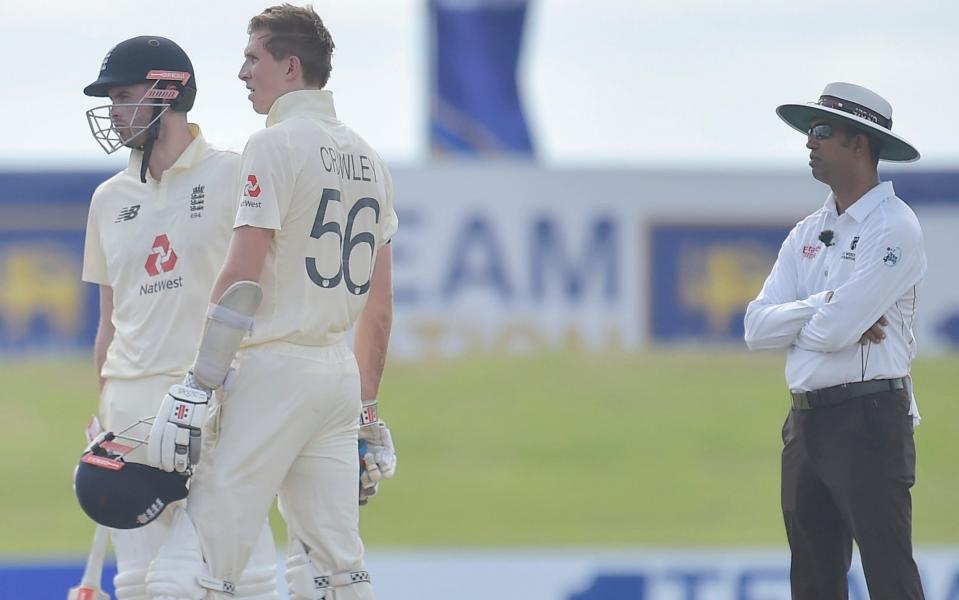England against spin: the differing mindsets of Dom Sibley and Zak Crawley

From his days in the Kent academy, the young Zak Crawley identified what would determine whether he made good on his ambitions of succeeding in Test cricket: how he played extreme pace and high-quality spin bowling. With unusual single-mindedness, Crawley focused on developing his game against these two types of bowling, more than the seamers who made up most of his county opponents.
Crawley’s analysis - that what he needed to ready himself for Test cricket was different than what he needed to do in the county game - was astute. So different are the pitches and types of bowlers who thrive that County Championship cricket is akin to a different sport from Test cricket. When batsmen are elevated from the county game to Test cricket, they don’t so much face more difficult bowling as a challenge of a different order altogether, like being top of Geography at school and then studying Russian at university.
In the County Championship, his England opening partner Dominic Sibley has been one of the finest players of spin bowling in recent years. Excluding Test matches, Sibley averages 70 against spin in first-class cricket.
If such pedigree seems hard to reconcile with Sibley’s uncertainties against spin in Sri Lanka, it only emphasises how far removed Test cricket is from the county game. In 80 previous first-class games, Sibley had only opened against a spinner in three innings; in Galle he has done so in both innings.
After edging Lasith Embuldeniya to slip in the first innings, Sibley was greeted by Embuldeniya taking the new ball once again in the second innings. Fielders huddled in around the bat, chirping. The pitch was offering appreciable turn. The fate of a Test match was not yet decided.
Sibley’s first four balls turned away, the fourth spinning profusely and being safely left alone. Embuldeniya’s fifth delivery to him shaped up as being the same, but this appearance concealed that it was bowled from slightly wider of the crease and was an arm-ball. Sibley got his bat out of the way, hoping to prevent the ball claiming his edge. Instead, he merely cleared the path for the ball to uproot his off stump.
Struggles against spin this Test have continued a trend in Sibley’s embryonic Test career. While he has performed admirably against pace bowling, he has been cumbersome against spin. Sibley has lacked either solidity in his defence or the ability to accumulate reliably - witness how at times he was choked off by the modest off spin of Roston Chase last summer, seeming unable to navigate the ball past short midwicket. His Test average against spin is now 26, barely a third of his record in other first-class games. The disparity reflects how even being an outstanding player of spin in county cricket - when spinners are of lower quality and bowl less - says almost nothing about a batsman’s capacity to thrive against spin in the Test arena.
Indeed, England recognise as much. “County cricket itself isn't necessarily reflective of international cricket,” England’s performance director Mo Bobat has said. “If you look at the evidence, we've got enough to know that the difference between pace bowling and spin bowling in international cricket and domestic cricket is stark.”
For Crawley, Galle has offered a reminder of why he has gone to such lengths to try and develop his game against high-quality spin, including organising a trip to Mumbai and Pune to face local spinners for upwards of four hours a day in the nets. He had showed his capabilities by playing Yasir Shah with panache during his 267 in England’s last Test.
That wonderful innings illustrated Crawley’s success in preparing himself for the rigours of Test cricket. But in this Test he has been forced to confront a completely novel challenge: opening against spin. Until getting to Sri Lanka, Crawley had never opened in a first-class game against spin; in the second innings he was even confronted by spin from both ends. Crawley was fortunate to survive his second ball, when his edge off Dilruwan Perera was dropped by Niroshan Dickwella; instead, he joined Sibley in being dismissed by Embuldeniya when he slashed a drive to gully.
So two young batsmen who had earned their selection through top-order runs, and then endorsed it by succeeding in South Africa and at home last summer, had floundered when faced confronted with cricket played at a different beat. In both innings, both openers were dismissed for single figures by Embuldeniya, a spinner for whom taking the new ball seems as routine as brushing his teeth.
It was a microcosm of what Sibley and Crawley can expect in the five Tests in Asia to come. It is a winter that will not merely test every iota of their techniques and temperaments against spin, but will also be unlike any other that they have faced before.

 Yahoo Sport
Yahoo Sport 





































